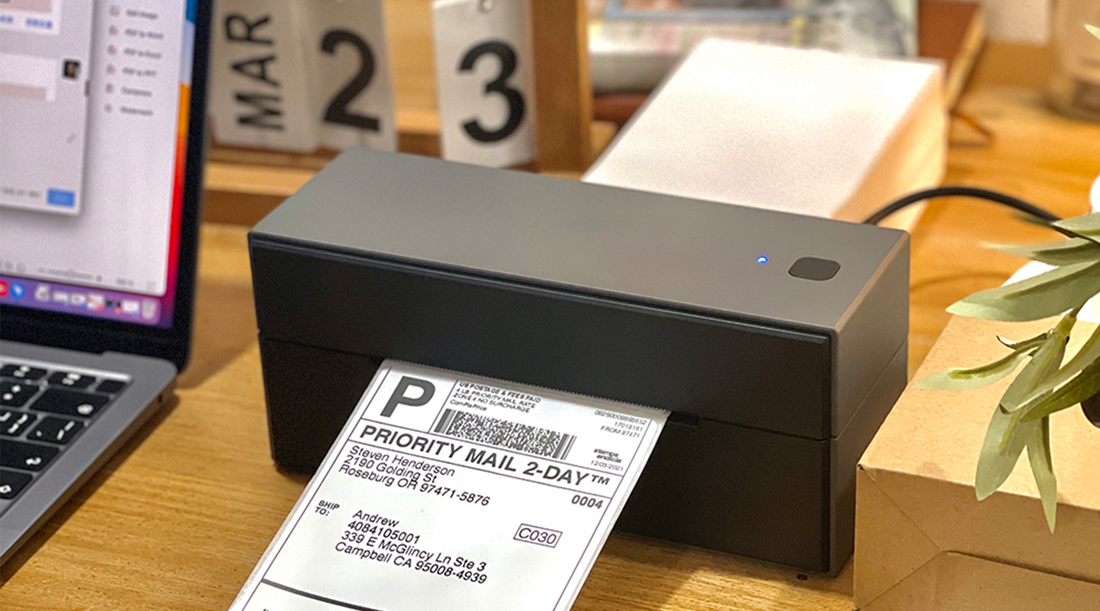Difference Between Inkjet and Thermal Printers

Inkjet and thermal printers are two of the most common types of printing technology. Both systems use heat and pressure to produce printed text, images, and graphics. But the way that inkjet and thermal printers work is quite different from one another. In this article we will discuss how each type of printer works in order to help you understand how they differ from each other so that you can make an informed decision about which one is right for your needs!
You may also like:
How Does a Thermal Printer Work?
A Smart Investment for Etsy Sellers: The Munbyn Bluetooth Label Printer
What Damages Thermal Printhead?
How Inkjet Printers Work
An inkjet printer uses an ink cartridge to store the printer's ink. The cartridge contains a sponge-like material that holds the necessary amount of printer ink and is inserted into the printer when it needs to be replaced.
When you print, the ink from your cartridge passes through a small hole on top and onto paper as it passes through an opening inside your device. A heating element then heats up this liquid to turn it into solid dots on your page. Each color has its own nozzle, and when they line up correctly with each other, they create different shades of gray or color in between them.

How Thermal Printers Work
Thermal printers work by applying heat to transfer ink from a ribbon onto the paper. The ribbon is made of carbon particles, which are black when they come out of the printer. When you put a piece of paper in your thermal printer, the heat causes these particles to melt and fuse together, creating dark spots on your page.
Print Speed
The print speed between inkjet printers and thermal printers can vary significantly, based on the specific models being compared and their intended use cases. When comparing print speeds, it's important to consider the nature of the printing task.
If you're looking to print full-page documents, especially with varied content, an inkjet printer's PPM metric (pages per minute) is more relevant, with typical values ranging from 20 to 60 pages per minute. For applications involving labels, barcodes, or receipts where quick and continuous printing is required, a thermal printer's IPS metric (inches per second) is a better indicator of performance, with common speeds falling between 2 to 8 inches per second.
Quality of the Print
For quality and accuracy of text printing, thermal printers are the best choice. They produce crisp results with sharp characters and lines. This is especially true when printing small texts or numbers.
Inkjet printers, on the other hand, are better suited for photo printing because they can create high-resolution images with excellent clarity and vivid colors.
Thermal printers are also not as good as inkjet printers in terms of color reproduction but can still produce decent looking graphics that are acceptable for most business applications.
Dependability and Longevity
Thermal printers are more dependable and have a longer lifespan than inkjets. Inkjet printers can be very expensive to maintain and may experience problems with the print head. Thermal printers, on the other hand, are more reliable and come with less maintenance costs.
Portability
As mentioned earlier, thermal printers are more portable than inkjet printers. This is because they’re not as bulky and do not require heavy duty paper to print on. You can easily carry them around in a backpack when you need to go somewhere with your work. If you want to print something small like shipping labels or price tags at home then a thermal printer is definitely better suited for this purpose because its lightweight nature makes it easy to carry around.
Cost Consideration
Upfront Cost
Inkjet printers are generally less expensive to purchase initially compared to thermal printers, making them a popular choice for home users and small businesses. In contrast, thermal printers typically have a higher initial cost, particularly for industrial-grade models that are built for high-volume printing environments.
Operating Cost
The ongoing costs for inkjet printers can be significant because they require regular purchases of ink cartridges, which can be expensive. Thermal printers, however, do not require ink or toner cartridges, which reduces operating costs. You only need to purchase thermal paper rolls.
Maintenance Cost
Inkjet printers may require regular maintenance to prevent the ink from clogging the printer heads, which adds to the cost. In addition, the print heads themselves may need to be replaced after a certain period, adding to the expense. On the other hand, thermal printers usually have fewer moving parts and do not use liquid ink, which can lead to lower maintenance costs.
In summary, inkjet printers have a lower upfront cost but higher ongoing costs due to the price of ink cartridges and potential maintenance related to print head clogging. Thermal printers, on the other hand, might have a higher initial cost but usually benefit from lower maintenance needs and operating costs over time, particularly for high-volume printing tasks.
When considering the total cost of ownership, it's crucial to evaluate the expected print volume, the type of documents you'll be printing, and how these factors align with each printer's strengths and costs.
User Cases
As for the application scenarios, many households use inkjet printers for a variety of tasks, such as printing documents, school assignments, photos, and craft projects that require high-quality color prints. By contrast, thermal printers are often used in retail and hospitality environments to quickly generate receipts for customers or for printing shipping labels and barcode labels, which require high efficiency and convenience.
Choosing between an inkjet printer and a thermal printer depends largely on the specific printing needs of the user. Each has its advantages and ideal contexts, and the choice should align with the type of output desired, the volume of printing, and the operating environment. If you need fast printing for your business and do not mind paying more for it, then a thermal printer for shipping labels may be perfect for what you're looking for!
|
Feature |
Inkjet Printers |
Thermal Printers |
|
Printing Method |
Use of liquid ink |
Use of heat-sensitive paper |
|
Print Speed |
Variable; typically good for moderate-speed |
Fast; designed for quick printing |
|
Print quality |
High-resolution images |
Lower resolution |
|
Longevity |
Prone to clogging if not used regularly |
Longer lifespan with fewer moving parts |
|
Portability |
Varies by model |
More portable due to a compact size and lack of liquid |
|
Cost |
Lower Initial cost, but higher long-term cost |
Higher Initial cost, but lower long-term cost |
|
Use Cases |
Occasional use: home and office document printing |
Retail and business use; shipping labels, receipts and barcode labels printing |
Conclusion
When you're looking for a printer, it's important to consider the type that is best suited for your needs. If you want something more portable or less expensive than an inkjet printer, then consider a thermal printer. You will have to spend some time figuring out if it’s right for your business though!


